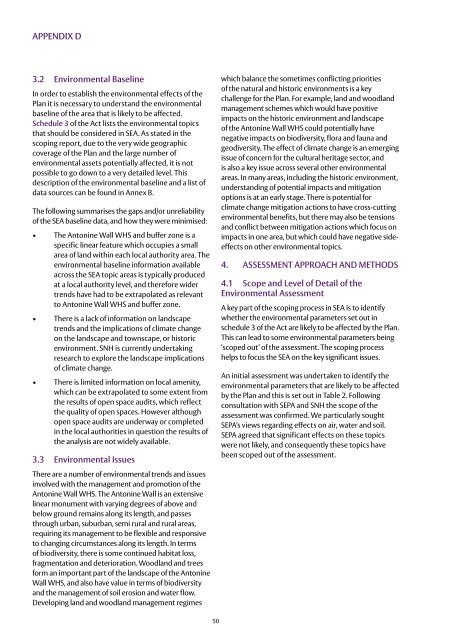The Antonine Wall Management Plan 2013-18 - Glasgow City Council
The Antonine Wall Management Plan 2013-18 - Glasgow City Council
The Antonine Wall Management Plan 2013-18 - Glasgow City Council
Create successful ePaper yourself
Turn your PDF publications into a flip-book with our unique Google optimized e-Paper software.
appendix D<br />
3.2 Environmental Baseline<br />
In order to establish the environmental effects of the<br />
<strong>Plan</strong> it is necessary to understand the environmental<br />
baseline of the area that is likely to be affected.<br />
Schedule 3 of the Act lists the environmental topics<br />
that should be considered in SEA. As stated in the<br />
scoping report, due to the very wide geographic<br />
coverage of the <strong>Plan</strong> and the large number of<br />
environmental assets potentially affected, it is not<br />
possible to go down to a very detailed level. This<br />
description of the environmental baseline and a list of<br />
data sources can be found in Annex B.<br />
<strong>The</strong> following summarises the gaps and/or unreliability<br />
of the SEA baseline data, and how they were minimised:<br />
• <strong>The</strong> <strong>Antonine</strong> <strong>Wall</strong> WHS and buffer zone is a<br />
specific linear feature which occupies a small<br />
area of land within each local authority area. <strong>The</strong><br />
environmental baseline information available<br />
across the SEA topic areas is typically produced<br />
at a local authority level, and therefore wider<br />
trends have had to be extrapolated as relevant<br />
to <strong>Antonine</strong> <strong>Wall</strong> WHS and buffer zone.<br />
• <strong>The</strong>re is a lack of information on landscape<br />
trends and the implications of climate change<br />
on the landscape and townscape, or historic<br />
environment. SNH is currently undertaking<br />
research to explore the landscape implications<br />
of climate change.<br />
• <strong>The</strong>re is limited information on local amenity,<br />
which can be extrapolated to some extent from<br />
the results of open space audits, which reflect<br />
the quality of open spaces. However although<br />
open space audits are underway or completed<br />
in the local authorities in question the results of<br />
the analysis are not widely available.<br />
3.3 Environmental Issues<br />
<strong>The</strong>re are a number of environmental trends and issues<br />
involved with the management and promotion of the<br />
<strong>Antonine</strong> <strong>Wall</strong> WHS. <strong>The</strong> <strong>Antonine</strong> <strong>Wall</strong> is an extensive<br />
linear monument with varying degrees of above and<br />
below ground remains along its length, and passes<br />
through urban, suburban, semi rural and rural areas,<br />
requiring its management to be flexible and responsive<br />
to changing circumstances along its length. In terms<br />
of biodiversity, there is some continued habitat loss,<br />
fragmentation and deterioration. Woodland and trees<br />
form an important part of the landscape of the <strong>Antonine</strong><br />
<strong>Wall</strong> WHS, and also have value in terms of biodiversity<br />
and the management of soil erosion and water flow.<br />
Developing land and woodland management regimes<br />
which balance the sometimes conflicting priorities<br />
of the natural and historic environments is a key<br />
challenge for the <strong>Plan</strong>. For example, land and woodland<br />
management schemes which would have positive<br />
impacts on the historic environment and landscape<br />
of the <strong>Antonine</strong> <strong>Wall</strong> WHS could potentially have<br />
negative impacts on biodiversity, flora and fauna and<br />
geodiversity. <strong>The</strong> effect of climate change is an emerging<br />
issue of concern for the cultural heritage sector, and<br />
is also a key issue across several other environmental<br />
areas. In many areas, including the historic environment,<br />
understanding of potential impacts and mitigation<br />
options is at an early stage. <strong>The</strong>re is potential for<br />
climate change mitigation actions to have cross-cutting<br />
environmental benefits, but there may also be tensions<br />
and conflict between mitigation actions which focus on<br />
impacts in one area, but which could have negative sideeffects<br />
on other environmental topics.<br />
4. Assessment Approach and Methods<br />
4.1 Scope and Level of Detail of the<br />
Environmental Assessment<br />
A key part of the scoping process in SEA is to identify<br />
whether the environmental parameters set out in<br />
schedule 3 of the Act are likely to be affected by the <strong>Plan</strong>.<br />
This can lead to some environmental parameters being<br />
‘scoped out’ of the assessment. <strong>The</strong> scoping process<br />
helps to focus the SEA on the key significant issues.<br />
An initial assessment was undertaken to identify the<br />
environmental parameters that are likely to be affected<br />
by the <strong>Plan</strong> and this is set out in Table 2. Following<br />
consultation with SEPA and SNH the scope of the<br />
assessment was confirmed. We particularly sought<br />
SEPA’s views regarding effects on air, water and soil.<br />
SEPA agreed that significant effects on these topics<br />
were not likely, and consequently these topics have<br />
been scoped out of the assessment.<br />
50












![Elgin Cathedral Wedding Brochure [pdf, 544kb] - Historic Scotland](https://img.yumpu.com/22301571/1/190x151/elgin-cathedral-wedding-brochure-pdf-544kb-historic-scotland.jpg?quality=85)



